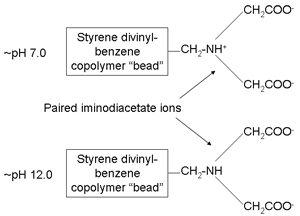Archival Notice
This is an archive page that is no longer being updated. It may contain outdated information and links may no longer function as originally intended.
Home | Glossary | Resources | Help | Contact Us | Course Map
Chelating resins have been used in ion-exchange columns, trace metal removal, metal analysis, and water testing in environmental and agricultural laboratories. In clinical applications and biomedical research, chelating resins can be used to remove or assay cations in whole blood or urine, to remove contaminants from buffers and stock solutions, and to prepare samples for nuclear magnetic resonance spectroscopy.
Chelex®, like most chemicals, is supplied in various grades of purity. Analytical grade Chelex®100 resin is highly purified and most suitable for forensic DNA applications.
Chelex®100 resin is composed of styrene divinylbenzene copolymers with paired iminodiacetate ions. The iminodiacetate ions act as chelators for binding polyvalent metal ions. Chelex®100 is very effective in binding metal contaminants with a high selectivity for divalent ions, without altering the concentration on non-metal ions.06
The extraction is set up under aqueous alkaline conditions. In this environment, Chelex®100 has an increased affinity for heavy metal cations such as Ca2+, Mn2+, and Mg2+, in contrast to its affinity for Na+. One benefit of using the Chelex extraction is that divalent heavy metals can introduce DNA damage at high temperature (e.g. 100oC) and removing the ions can diminish this concern. In addition, magnesium is necessary for nuclease activation, and binding these ions inactivates the enzyme.
Read more about PCR in the Quantitation module of this course.
The extraction process involves boiling a sample in a 5% suspension of deionized water and Chelex®100. The alkalinity of the suspension and the boiling process disrupts the cell membranes, destroys cell proteins, and denatures the DNA. The suspension is then centrifuged, separating the resin and cellular debris from the supernatant containing the denatured DNA. The DNA can then be amplified.05
Additional Online Courses
- What Every First Responding Officer Should Know About DNA Evidence
- Collecting DNA Evidence at Property Crime Scenes
- DNA – A Prosecutor’s Practice Notebook
- Crime Scene and DNA Basics
- Laboratory Safety Programs
- DNA Amplification
- Population Genetics and Statistics
- Non-STR DNA Markers: SNPs, Y-STRs, LCN and mtDNA
- Firearms Examiner Training
- Forensic DNA Education for Law Enforcement Decisionmakers
- What Every Investigator and Evidence Technician Should Know About DNA Evidence
- Principles of Forensic DNA for Officers of the Court
- Law 101: Legal Guide for the Forensic Expert
- Laboratory Orientation and Testing of Body Fluids and Tissues
- DNA Extraction and Quantitation
- STR Data Analysis and Interpretation
- Communication Skills, Report Writing, and Courtroom Testimony
- Español for Law Enforcement
- Amplified DNA Product Separation for Forensic Analysts



